There are over 400 common beans (Phaseolus vulgaris) and who knows how many cultivars. With so many different types of beans, it’s difficult to know where to begin! Especially if you’re tight on space in the garden, then it may be a hard task to narrow down which will perform best in your area and which will provide you with the harvest you’re looking for.
It’s important to consider how you want to use your beans. The two main categories are beans for fresh eating and beans for drying and long-term storage. Most beans can be eaten fresh, though some beans are considered dual-purpose and fall into both categories.
Beans come in many different varieties, such as wax beans, broad beans, butter beans, pole beans, runner beans, yardlong beans, and bush beans. For brevity’s sake, we’ll discuss what you would generally buy in the grocery store instead of including lentils, cocoa beans, and green peas!
The combination of bean and rice dishes makes a delicious meal and a complete protein. They both lower cholesterol and blood sugar. You’ll find cooked beans in Middle Eastern dishes. Canned chickpeas are the main ingredient in hummus. Find them in pasta dishes and minestrone. In Latin America, refried beans and a multitude of other bean dishes are staples.
In the United States, baked beans are a popular southern side, along with bean salads. They are also used in desserts in Japan, China, and Hawaii, where many dishes feature sweetened adzuki bean paste. Soybeans can also be turned into a dairy substitute known as soy milk. And we can’t forget to mention the ever-popular mung bean soup!
The benefits of growing your own beans are pretty much countless, but a major pro is the fact that common beans are easily stored. String beans are delicious when eaten raw but can also be frozen, or turned into canned beans. So many beans are suitable for drying, giving you multiple years of storage. Dried beans can be soaked and cooked in soups and stews too.
Fresh Eating
Green beans and string beans are the most common beans for fresh eating. Some fava beans and mung beans are also great when eaten fresh. Many green beans rarely make it into the house because they’re so delicious right off the plant! They’re perfect for steaming, sauteing, canning, and freezing.
Here’s a list of reliable plants that produce excellent fresh green beans. Some of the plants on this list are grown to produce a crop that can be stored as well.
Blue Lake 274

With exceptional flavor and tenderness, this green bean is exceptionally good for fresh eating as well as freezing for longer-term storage. Snag some Blue Lake 274 Bush Bean seeds from Botanical Interests! This is a great container variety for small space gardeners.
Each pod is roughly 5 to 6 inches long at full maturity, and produces white beans that are perfectly paired when sauteed with garlic. Their disease resistance means you’ll have large harvests of beans you can eat fresh, or dry and store for later.
Contender

This green bean is considered an early producer, providing fresh beans in only 50 days! Contender Bush Bean seeds grow beans with delicious, intense flavor. They’re aren’t hard to cultivate either. This stringless variety was developed by growers in 1949, and has been a favorite among bean horticulturalists ever since.
Resistance to mosaic virus and mildews is what makes this plant so successful. From Contender, you can expect continuous harvests, and tons of purple flowers throughout the season. You can eat them right off the plant, or cook them in your kitchen. Either way, you’ll love them.
Ferrari

The Ferrari Bush Bean produces tender, crisp, and delicious fuzz-free pods that are glossy and smooth to the touch. This variety is a heavy producer, and has no problems with anthracnose, or mosaic virus.
The plants produced from these beans are smaller than most, making them great for grow bags and larger containers. They grow up to 16 inches season, meaning you can grow them if your space is a porch or a patio. Grow Ferrari for ensuring you’re always stocked up on beans!
French Filet

You can expect delicate flavor from French Filet Bush Bean seeds, even when the pods are picked young. These gourmet beans are also perfect when they are steamed or sauteed. The plant produces pencil-thin beans, akin to those served in fine dining restaurants.
French filet beans are best cooked very lightly, to preserve their delicious crunch. You can keep them at their roughly 4 inch length, or cut them into smaller pieces, but their tenderness may be more evident in smaller pieces. Plant these seeds and you’ll have lovely delicate beans in just two months.
Gold Rush

The Gold Rush Bush Bean variety produces large crops of golden-white pods known for holding their tender texture and delicate flavor longer than other snap beans. This is a great plant for gardeners who like to add color and interest to their annual veggies. It’s resistant to curly top and mosaic viruses.
If you end up harvesting more than you can eat, Gold Rush freezes very well. And if you don’t make it to the plant in time to harvest, no worries! The beans hold their quality quite well on the plant for longer than most. You’ll be harvesting from 54 days on.
Jade

Dark green, just like polished gemstone, the pods of Jade Bush Beans are sweet and tender. The deep green plants with white flowers are super productive. The beans are perfect fresh from the garden, too. Because the plants hold the beans up, you’ll have less trouble with tip rot.
There is so much Jade has to offer, including resistance to bean mosaic virus, curly top, and rust. The long 6.5 inch beans are a favorite among gardeners, and the plant stature allows for container growing if that is what you prefer.
Provider

As its name would suggest, this plant provides a large harvest! Provider Bush Bean plants are upright and compact — perfect for small spaces. They are also bushy plants that are easy to harvest. You’ll have so many beans, you’ll have to give some away.
You’re not going to have problems with mosaic virus, pod mottle virus, or powdery mildew. And all those beans may not be eaten as soon as you harvest, but they’re great for freezing or canning. Provider is perfectly able to germinate in cool soil, for those in areas where spring comes later.
Roma II
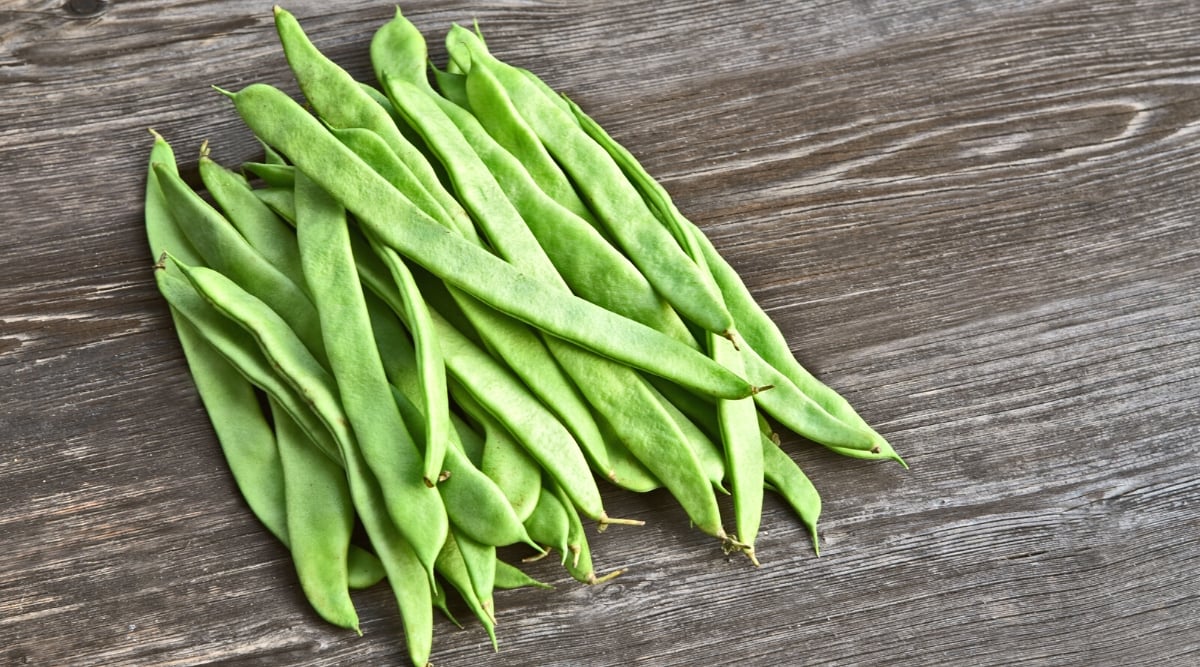
A classic Italian Romano bean on easy-to-pick bushy plants, the beautiful flat green pods of Roma II Bush Beans are filled with tons of flavor! You won’t find snap beans like this in stores. They develop fiber and beans very slowly, making it possible to harvest a little later than you would with other varieties.
Roma II beans are adaptable in the kitchen. Their delicate fresh taste remains if you need to can or freeze them. The plants themselves don’t succumb to rust or certain strains of mosaic virus, and the 4 to 5 inch pods are tender, especially when eat right off the bush.
Royal Burgundy

Bright violet-purple pods magically turn emerald green after cooking! The Royal Burgundy Bush Bean variety is also very tender and stringless. The light green leaves of the plant gracefully offset the violet pods, adding a dash of color and anthocyanin to your garden.
This is another variety that works well for gardeners with cooler springs. The plant tends to deter bean beetles, and is ready in roughly 55 days. The flowers mimic the color of the pods, with a deep purple hue.
Tavera
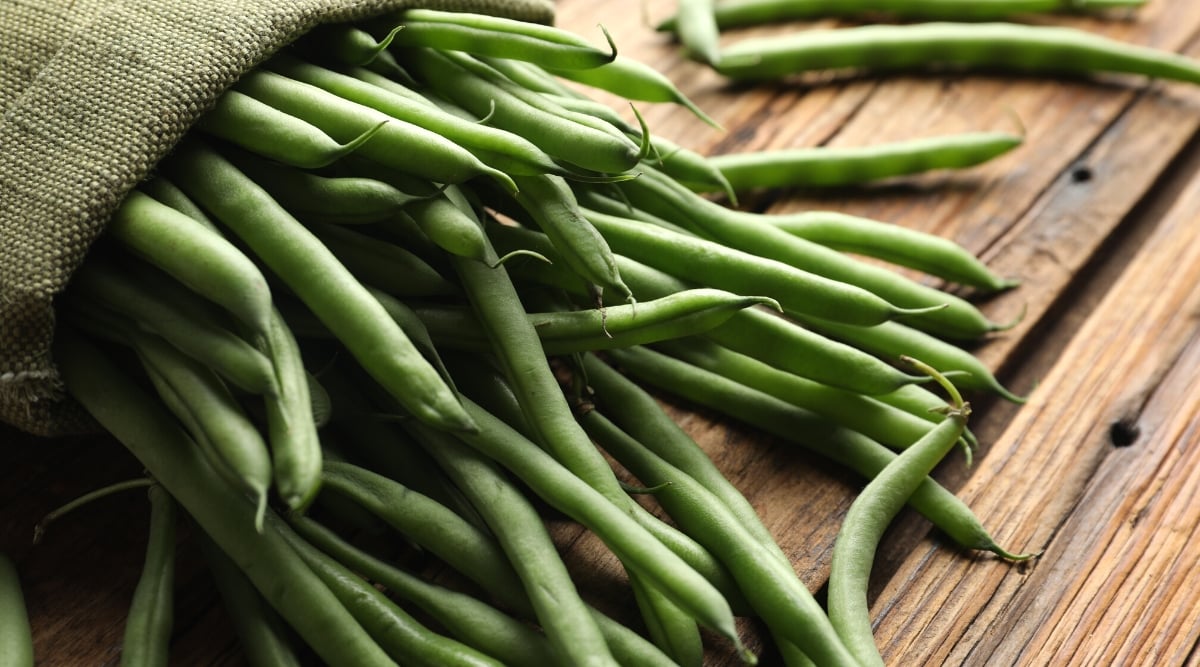
Similar to the French Filet, this variety was produced specifically for the French restaurant trade. The Tavera Filet Bush Bean grows exquisitely tender and stringless beans. The 15 to 20 inch tall plant works very well in smaller space gardens, growing happily in containers.
Mosaic virus and anthracnose aren’t present among these plants due to their resistance. Because the plants need no staking, this is a great bean plant for beginners, too. Enjoy the delicate beans within a couple of months of planting.
Windsor

These Fava beans have a delectable nutty bean/pea flavor. Windsor Fava Beans are an 1863 heirloom broad bean that is easy to shell and is delicious raw or cooked. It can also be dried for long-term storage and makes an excellent cover crop! However, ensure you do not have favism before you grow these.
The new leaf tips are an excellent garnish, and the flowers are stunning with their black and white pattern. These two things make the plant multi-functional, great for accents in flower beds. Fava beans also tend to be suited to cooler weather, and can withstand freezes. If you’re a gardener in an area with frost-prone springs, consider Windsor!
Blue Lake FM-1K

This is a longtime favorite pole bean variety. Blue Lake FM-1K Pole Beans are heavy producers that will ensure plenty of beans for freezing and canning. The 5 to 8 foot plants produce pods that are about 5 to 7 inches long.
If vines are your bag, plant this one! You’ll have tender beans you can harvest all spring and summer. They will resist common mosaic virus, and grow best in areas where the weather doesn’t often reach highs of 90°F (32°C).
Kentucky Wonder

You can expect excellent flavor, tender pods, and heavy production from Kentucky Wonder Pole Bean Seeds. This variety has been around since the late 19th century and has been a favorite ever since!
The adoration of this bean could have to do with its 9 inch long pods that are curved and ovular. It could also be related to its multiple abilities: to be shelled, eaten fresh, frozen, or dried. This is an excellent choice for hot weather growers where other beans may slow production in heat.
Trionfo Violetto

This Italian variety produces slim purple pods that are not only gorgeous on your plate but in the garden as well! Grow Trionfo Violetto Pole Beans in 65-75 days for fresh eating of the purple beans. When you cook them, they magically turn green.
For large, 6 to 8 foot plants with tons of pods, Trionfo Violetto provides! Its lavender flowers mimic the purple stems and veins of the plant, offsetting the green of the leaves. The pods grow to 6 to 8 inches when mature, and offer a delectable flavor.
Seychelles

Deep green stringless pods come early (within 55-65 days!) and continue producing up until the first frost. The Seychelles Pole Bean variety is also disease resistant, fending off anthracnose and common bean mosaic virus. The 4 to 6 inch pods may be slower to develop, but they’re worth the wait.
Expect to provide a trellis for the 7 to 9 foot long vines of Seychelles. Because these are sensitive to frost, they are better in a warm spring and summer garden free of cold weather.
Orient Wonder

This is a pole yardlong variety that produces 18-inch long pods! They can be cut up and used fresh like any snap bean. Orient Wonder Pole Yard Long Beans are particularly heat tolerant, which makes them great for Southern gardens.
Next to their heat tolerance, Orient Wonder can withstand fluctuations in precipitation and temperature easily. Their indestructible nature is surpassed by the incredibly long pods, which reach up to 30 inches sometimes! More often you’ll harvest those foot-long to 1.5 foot long pods, though.
Gold Mine
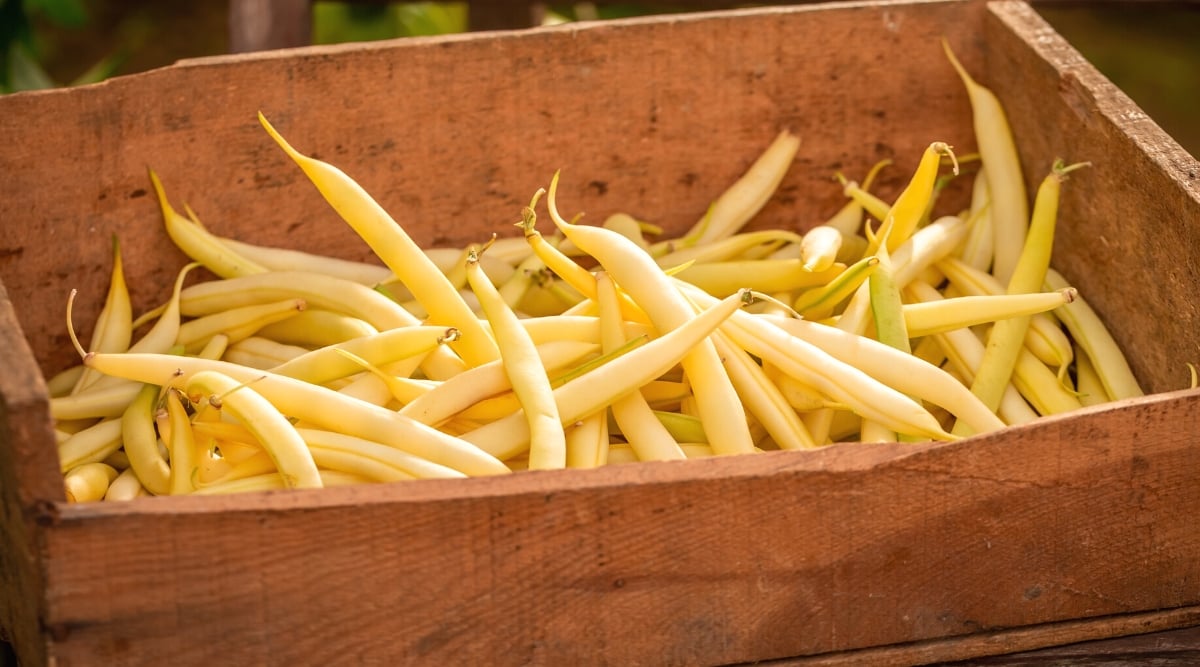
This is a high-yielding ultra sweet yellow wax bean, that is produced in large clusters for easy picking. This bush variety is container friendly, and grows beans that are less than half a foot long. You can expect an early yield from the plants, and production within 55 days.
Many regions are suitable for a crop of Gold Mine beans. Eat them straight from the vine, or chop them up and eat them raw on a salad. Alternatively, cook them like a regular green bean. It doesn’t matter how you enjoy them; they’ll keep their sweetness in any form.
Purple Queen

This heirloom variety produces beautiful purple beans that turn green after cooking. Another bush variety that is well suited to small spaces and container gardening, it’s also suited to areas with cooler spring and summer temperatures.
This is one of those purple varieties that turns green after cooking, emulating the deep green of its foliage. The texture of the beans is ever so tender, and the flavor is deep and complex, which should be of interest to gardeners who spring for interesting culinary delights.
Early Bush Italian

This bush bean is an early-fruiting (within 50 days) Italian heirloom that produces stringless pods. The pods are perfect for fresh eating, freezing, or canning. Plants don’t grow much taller than 16 to 18 inches, making them wonderful for container gardens.
If you have tons of pods, freeze them to enjoy later. You won’t want to skip the rich flavor of the 5 to 6 inch pods in the off-season. An early yield makes them easy in areas where the heat comes on at the beginning of summer.
Desperado

Super sweet dark green pods are produced by this plant. Thanks to slow-to-develop seeds, the beans have more time to produce sugars and flavonoids. This gives them an unmatched flavor! The densely clustered sets of blooms fade and grow to less than 6 inch beans.
The smaller stature of the plant goes well in interlpantings and container gardens. Even in hot summers, you’ll notice Desperado continues to produce. Drought and heat aren’t an issue either.
Mascotte

An All-American Selections winner, this variety produces 5 inch round, extra fine, stringless pods. This productive 20 inch tall dwarf plant is perfect for window boxes, pots, patios, and the small space garden. What’s so interesting about these seemingly regular looking beans is they grow above the foliage, for easy access.
The French name, Mascotte translates to “mascot” in English. We can attribute this name to the variety’s adaptability in the garden. You’re sure to yield lots of green beans when you grow it.
Fordhook No. 242
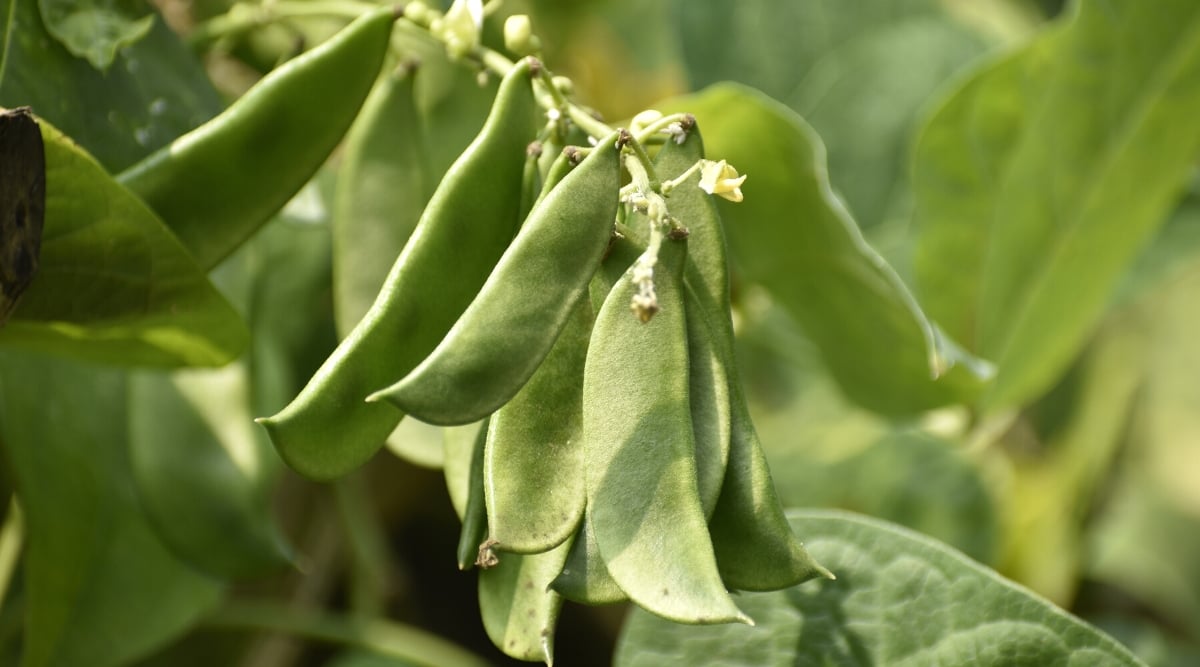
These lima beans, also referred to as butterbeans, are heat-resistant and thrive in adverse conditions. You should expect a nutty flavor profile from the 4 inch pods full of white beans. These will develop even in very hot conditions.
The standard of the lima bean varieties, Fordhook No. 242 takes longer to mature than others we’ve discussed up to this point, at roughly 80 days. However, because the plant will still produce in hot areas, you may not even notice the long maturation period.
White Half Runner

This runner bean is an heirloom classic that produces small 4 inch green pods with white beans with a delicious, sweet flavor. They’re perfect for canning and freezing if you have a particularly productive plant. They can also be dried and stored long-term.
This crop produces early, and provides abundant harvests. With plants that grow no more than 2 feet tall, you’ll have beans in just a couple of months.
Fortex

This is a stringless French variety that is mildly sweet, meaty, and savory. They are best picked between 6 to 11 inches long. For thinner beans, harvest at about 6 inches. These are excellent for fine dining, as their delicacy and flavor is prized among other beans.
While the flavor of standard beans, like Provider may be nutty, this one maintains its sweetness for some time. You’ll want to harvest often so you don’t have beans drying on the vine (unless that’s what you want!).
Yardlong Asparagus Bean

This heirloom variety produces 18 inch-long slender pods that are delicious steamed or sauteed. They also have no serious pest or disease issues. If you can keep up with the prolific nature of these plants, you’ll have tons of delicious beans you can eat within 80 days.
The vines of these plants are long, too, growing up to 108 feet in just one season. Originating in Asia, yardlong beans can withstand high heat and humidity with very little mildew contact.
King of The Garden

These lima beans (or butter beans) thrive in heat and humidity with very little pest and disease issues. This is a super productive climbing pole variety that produces starkly white beans. The vines are relatively short for pole varieties, topping out at 10 feet.
King of the Garden is an heirloom variety from 1883, introduced to the world from Frank S. Platt, a well known purveyor of seeds and seed catalogs. This cultivar is wonderful in container gardens.
Dragon’s Tongue
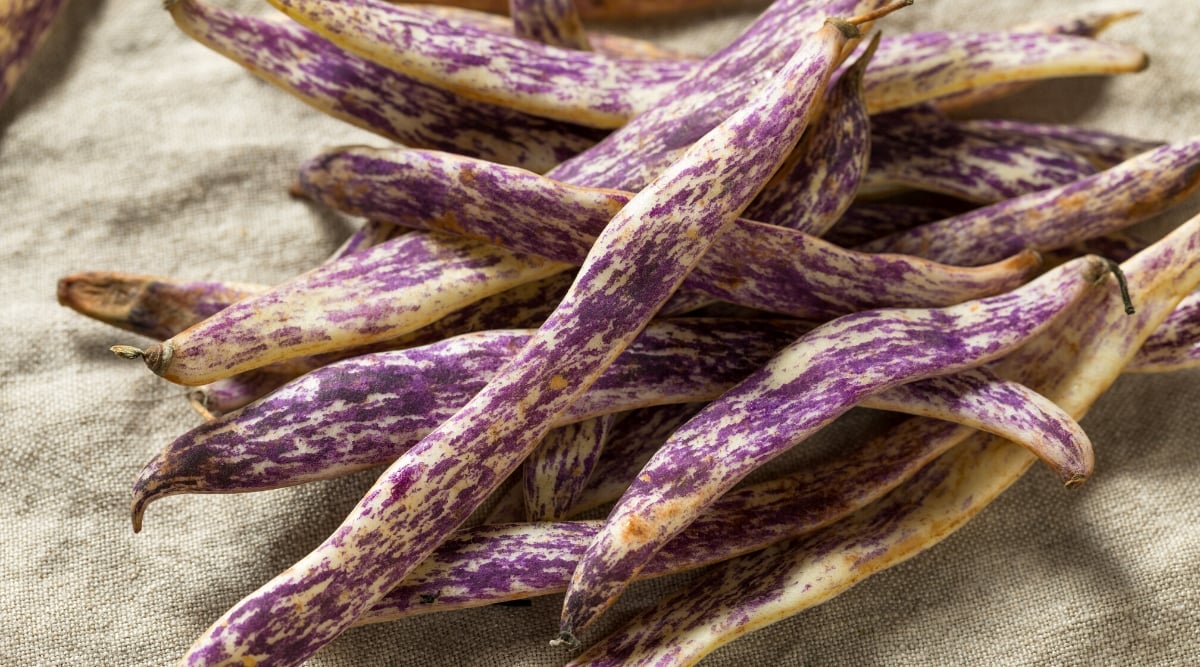
This Dutch wax bean produces cream-colored pods with vivid purple mottling that fades when the beans are cooked. The pods are stringless and wide. This bush variety is great for those looking to save space, as the plants grow no larger than 30 inches tall.
Dragon’s Tongue is a well-known flavorful heirloom that was developed in the 19th century. It’s a favorite among culinary gardeners due to its rich flavor. The compact plants are plentiful for seasoned and new gardeners alike.
Rattlesnake Snap

Also known as Preacher bean, this variety produces dark green pods streaked with purple. The seeds are light in color and splashed with dark brown, resembling a Rattlesnake’s coloration. This pole variety grows vigorously and can reach up to 10 feet!
This is a stringless variety with good resistance to drought. It prefers sandy soil, needing excellent drainage. But it does well in hot humid areas in the subtropics and tropical regions of the world. Particularly in coastal ranges, this plant thrives.
Winged Bean

This variety gets its name from the 4 “wings” that run down the length of the pod. Winged beans can be left to mature or can be eaten as young tender pods. Cook them, and their pods become soft and supple, unlike other beans which take on a fibrous consistency.
Many varieties of winged beans can reach up to 12 inches long. These beans hail from Papua New Guinea, from long before peoples there made contact with colonial forces. Gardeners in tropical climates can enjoy a long season of winged bean harvests.
Mung Bean

These popular beans are generally germinated in bulk and eaten as sprouts. However, you can plant and grow them just like any other bean. They are delicious when eaten fresh! Although they can also be left to dry and then used for sprouting.
They take longer to harvest than other varieties, with pods ready for picking at about 100 days. As a native of India and other parts of East Asia, the plants prefer tropical and subtropical climates. Out of the entire US, Oklahoma is the state that grows mung beans most.
Dried Beans
These beans are an excellent choice if you’re looking for shelf life and storage ability. They are usually cooked in soups, stews, and other hearty dishes. Most of them, of course, can also be eaten fresh! But are usually grown for their properties as dried beans.
You can leave some of these to dry on the vine, or remove them and put them in a climate controlled area for dehydrating. Whichever you choose, you’re going to love the end result.
California Blackeye #5

A home gardener favorite and Southern staple, the large, smooth seed of California Blackeye #5 Bush Cowpeas is well suited for drying. Although, the peas can also be eaten fresh, and the tender young pods can be eaten whole.
Like other beans if its kind, this variety loves heat and humidity. Southern gardeners can rely on California Buckeye, and so can those with unseasonably warm summers. With beans that are produced at the top of the plant, easy harvests are the name of the game.
Scarlet Emperor

This runner bean variety produces brilliant, rich-red flowers and is considered both ornamental and edible. The flowers of Scarlet Emperor Pole Runner Beans attract hummingbirds and other pollinators. Its sweet tasty pods can be eaten fresh or left to dry.
Young Scarlet Emperor beans are highly flavorful and beloved by culinary experts. Mature beans on the other hand make awesome candidates for drying. Plant multiple plants along a Florida weave for a wall of gorgeous crimson blooms.
Arikara Yellow

These seeds were originally obtained from the Arikara peoples of North Dakota and then introduced commercially in 1914. They produce yellow-tan seeds with red-brown eye rings. They have good drought tolerance and are great for drying for long-term storage.
In the kitchen, this bean is a star when baked. Braised with olive oil and rosemary, the beans are unforgettable. If you are looking for a bush bean with container capabilities and a shorter habit (up to 2 feet tall), Arikara Yellow is for you!
Calypso
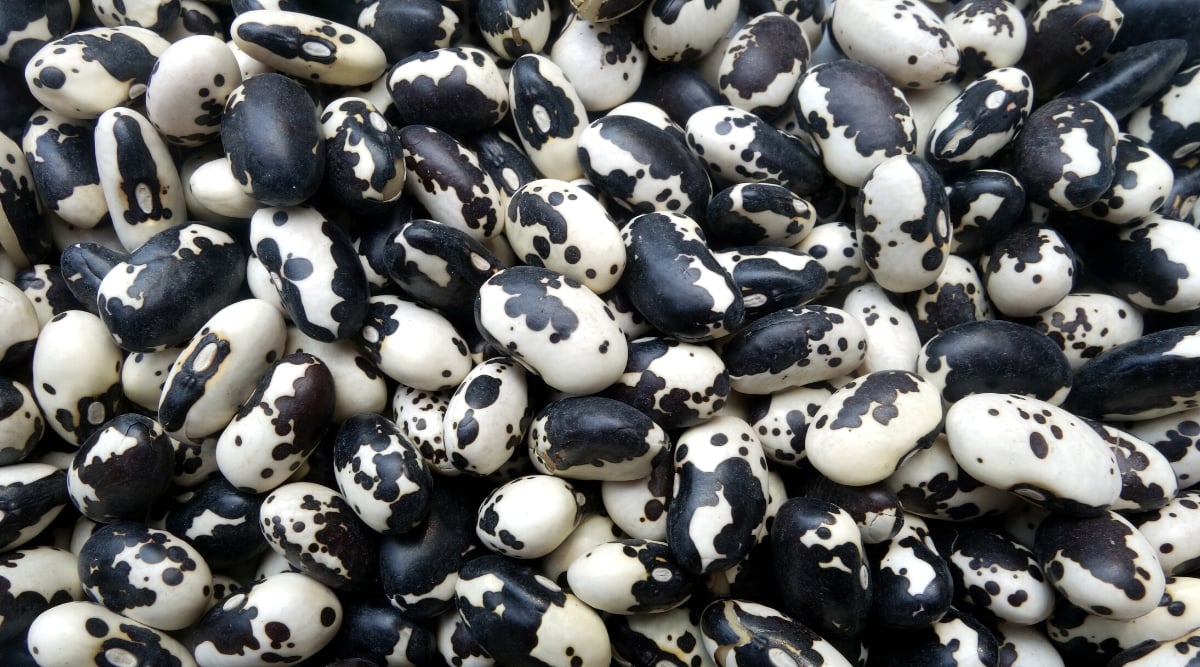
This variety is commonly called “yin-yang” and is hails from the Caribbean. This is one among those perfect beans for baking and soup-making. The seeds are round, black and white, and with a white eye. The plants are adaptable to multiple climates, both hot and cool.
Within 90 days you can enjoy a harvest of these interesting beans, which can even be eaten fresh as green beans in early stages. These small 15 inch tall plants are container ready, or can be planted among companions.
Lina Sisco’s Bird Egg
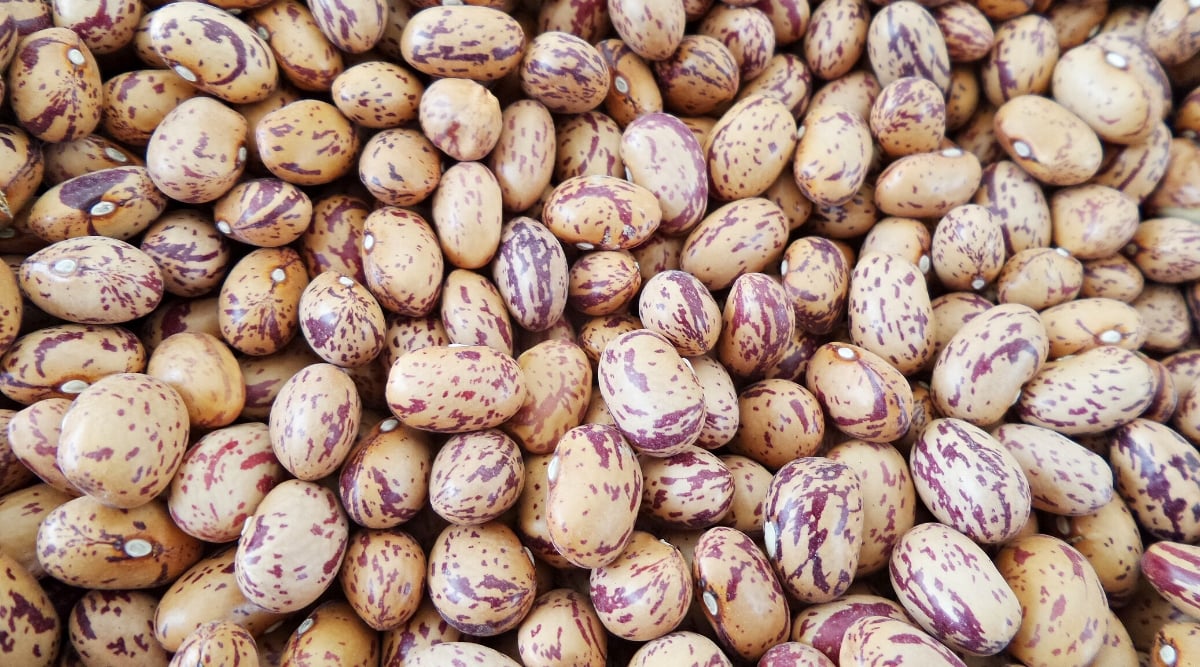
This family heirloom was brought to Missouri in a covered wagon in the 1880s by relatives of the founding members of the Seed Saver’s Exchange. It produces large, tan beans with maroon markings and is primarily used as a dried bean.
As a drying bean, you can bet the flavor of Bird Egg works amazingly in soups and casseroles. Some even can them. The plants are fairly small, reaching 2 feet at most. This means outdoor gardeners of all kinds can cultivate them.
Painted Pony

This dual-purpose bean is both delicious when eaten as young tender pods, as well as matured and used as a dried bean. The beans are brown and white, and they keep their markings in cooking. Wait 60 days for snap beans and 80 days for dry beans.
Painted Pony beans are excellent for soups, and the pods are tasty when chopped and added to salads. At a shorter height of 1.5 feet maximum, container gardens are superb growing environments.
Tiger’s Eye

Originally from Chile and Argentina, this variety is great for chili or refried beans. It produces tan beans with dark brown markings. In South America where they’re grown, they are called “pepa de zapallo”, which translates to pumpkin seeds. This is a testament to their appearance.
The flavor of the beans is starchy, and akin to a potato. The plants have a medium-range height, topping out at 3 feet. Therefore, they grow well on both sunny patios and in larger rows — and everything in between!
Henderson Bush

Also known as Dwaf Sieva, this variety was introduced in 1889 by Peter Henderson Company in New York. These dwarf lima beans are hardy, productive, and disease resistant. The creamy white beans are perfect for canning or drying.
Just as other limas do, this plant loves heat and humidity. No more than 2 feet tall, you’re able to grow Henderson Bush beans almost anywhere, as long as conditions are warm and sunny enough. Expect a high yield from this variety!
Sieva

Also called Small White or Carolina, this is a pole lima bean that has been popular for hundreds of years. Dark green 9 to 10 foot vines climb vigorously. They have a delicious butter bean flavor and can be dried for storage.
Sieva beans love heat! They can handle arid weather as well, as evidenced by their origins in the Andes mountains. The lush green foliage is covered in delicate white flowers just before production begins. Southern gardeners will have lots to harvest with this cultivar.
Agate

This very rare soybean can be eaten both fresh as edamame or dried for storage. The pods contain small olive-green seeds with brown saddles. They were originally collected by the USDA in 1929 in Sapporo, Japan.
You can expect lush, full harvests from the up to 2 foot tall plants. Grow them in containers, raised beds, or in the ground, and you’ll have plenty of beans. With just over 2 months to harvest, it’s well worth the wait.
Fiskeby

Bred by the late Dr. Sven Holmberg in Friskeby, Sweden, this soybean is excellent eaten as edamame and can be enjoyed dried or fresh. This early maturing variety thrives in northern climates where temperatures are cooler.
Southern gardeners may want to skip this one, as it doesn’t do as well in heat. But those with temperate summers can enjoy harvests in roughly 1.5 months. The creamy texture and nutty flavor of these soybeans can’t be beat.
Painted Lady Improved

This pole bean produces beautiful bicolored red and white blossoms that are very attractive to hummingbirds and moths. It is also known as Bicolor Runner and Painted Runner. It is less affected by warmer temperatures than other runner beans.
Vines of this cultivar climb up to 10 feet, and work well as a wall of pollinator lure! Much like the Emperor Scarlet Runner, you’ve got multiple benefits from planting this one. The beans are tasty too.
Sunset Runner

This is one of the oldest runner beans in existence, as it was already well-known in 1735 and listed in America as early as 1806. Small snap pods or green shell beans can substitute for lima beans in cooler climates.
The vines of Sunset runner are aggressive in the right environments. They are, in turn, highly productive, blooming tons of whitish-pink flowers in summer. Just like the other red-pigmented blooms, these attract pollinators. Create a wall of them in your garden next to your other veggie plants for maximum yields all around!
Bolita Beans

Bolitas are known for being sweeter, richer, and easier on the stomach than pinto beans. They were brought to Northern New Mexico and Colorado by the Spanish and adapted to high elevations.
This crop is perfect for hot, arid areas, particularly in the southwest portions of the US. Due to its deep root system, the plant can withstand periods of drought after it is well-established. They take a little longer to develop due to the conditions they’re used to growing in, and are ready in about 100 days.
Good Mother Stallard

The Good Mother Stallard variety produces gorgeous maroon and white beans that are delicious in baked bean dishes. This heirloom has been growing for generations, and is considered one of the most productive pole bean varieties. The beans are best for shelling or for cooking.
The long vines of this plant need a sturdy trellis for productivity, especially if you live in a region with somewhat temperate summers where they thrive. They may slow production in the heat, though. Some shade may benefit those planted in hot areas.
Pinto Garden Bean

Pinto beans are perfect for frijoles, burritos, and refried beans. This bean is excellent for drying and long-term storage. The small tan beans are well-known and widely used in many Mexican dishes.
Expect to grow semi-compact plants that run ever so slightly. Therefore if you’re working in containers, you may need to provide a little support. You don’t have to dry these and cook them later. The young green beans can be eaten raw right off the vine.
Light Red Kidney Bean
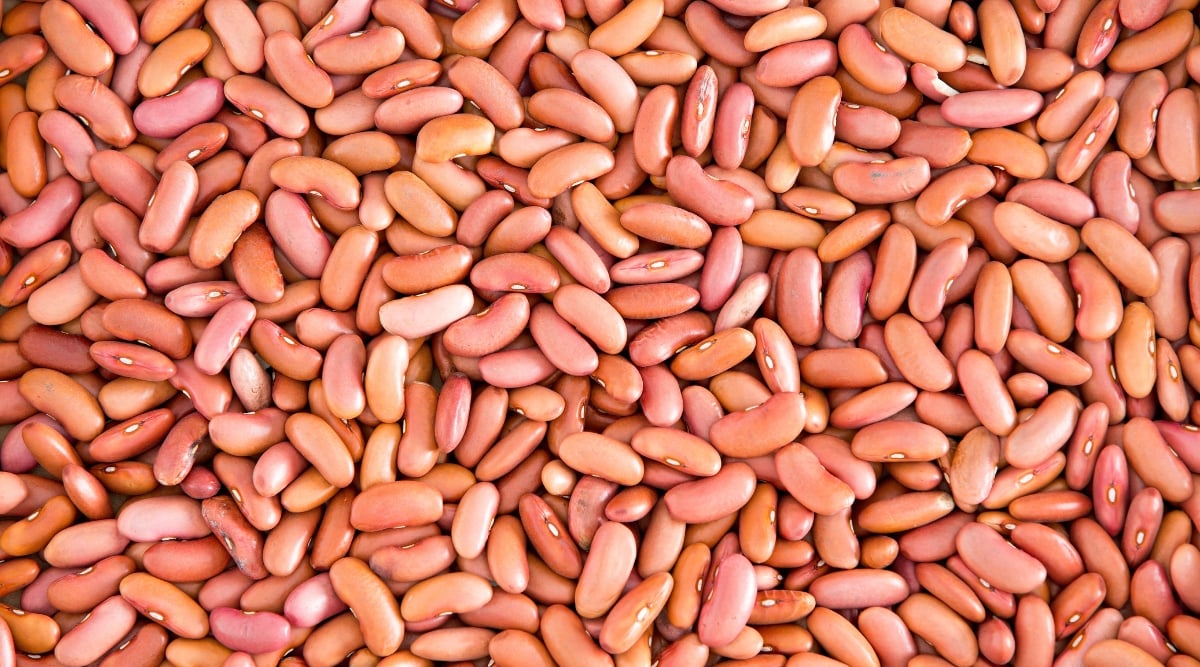
Light Red Kidney Beans are highly recognizable on store shelves. They have a mild bean flavor and are perfect for chili, bean salads, and soups. The plants for these beans are pretty small too, and do well in containers placed in lots of sunlight.
At about 90 days to maturity, you may have to wait until later in the season. But being able to incorporate them into your favorite soups and chilis is worth it. These are great for growing in parts of the Northeast US, were summers don’t typically rise above 90°F (32°C).
Silver Cloud Cannellini

An improved Cannellini bean with a meaty texture and dense, nutty flavor. These Cannellini beans make great shelling and cooking beans that can be dried for storage. The pods are green with bright pink streaking, adding a dash of texture to your warm weather season.
Instead of growing 8 beans inside the pod, like regular Cannellinis, there are 5 to 6 plump beans that mature within. Throw dried beans into minestrone, soups, and stews to soak up that delicious flavor for the rest of the year.
Vermont Cranberry Bean

Also known as Borlotti beans, Roman, and Saluggia beans, Cranberry beans are small, round, and red like cranberries. This variety produces pods that are pinkish-red, reliable, hardy, and easy to shell. The beans inside the pod look similar to the pod itself, sans the green.
Those with cooler, shorter seasons are sure to have success with Vermont cranberry beans. They’ve been grown this way since the 1800s, after all. Plants don’t get more than 2 feet tall, and the versatility of the fruit as snap peas, shelling beans, or dry beans adds to their desirability.
Kabouli Black

This plant produces black garbanzo beans, and is an ancient heirloom variety that has been passed down for ages since it was grown in its original homeland of Afghanistan. It starts well in cool weather, and production slows down in the heat. Therefore, hot weather gardeners should start these as soon as soil can be worked in spring.
Gardeners with a short season may enjoy the smoky flavor of these beans as fall comes on. At 2 feet tall, even patio gardeners can grow some of their own. You can enjoy these garbanzos just as you would the usual kind. The flavor will be slightly more complex, but oh, so good.
Dainagon

These adzuki beans are widely grown in Kyoto, Japan. This heirloom variety is used for desserts as red bean paste. To make the paste, the beans are boiled, mashed, and sweetened with sugar. They can also be dried and stored for future use.
If you don’t have a sweet tooth for red bean ice cream (like I do), the beans are great when they’re used in savory dishes too. Another 2 foot tall variety, lovers of this storied bean can grow them regardless of the space.
Lazy Housewife
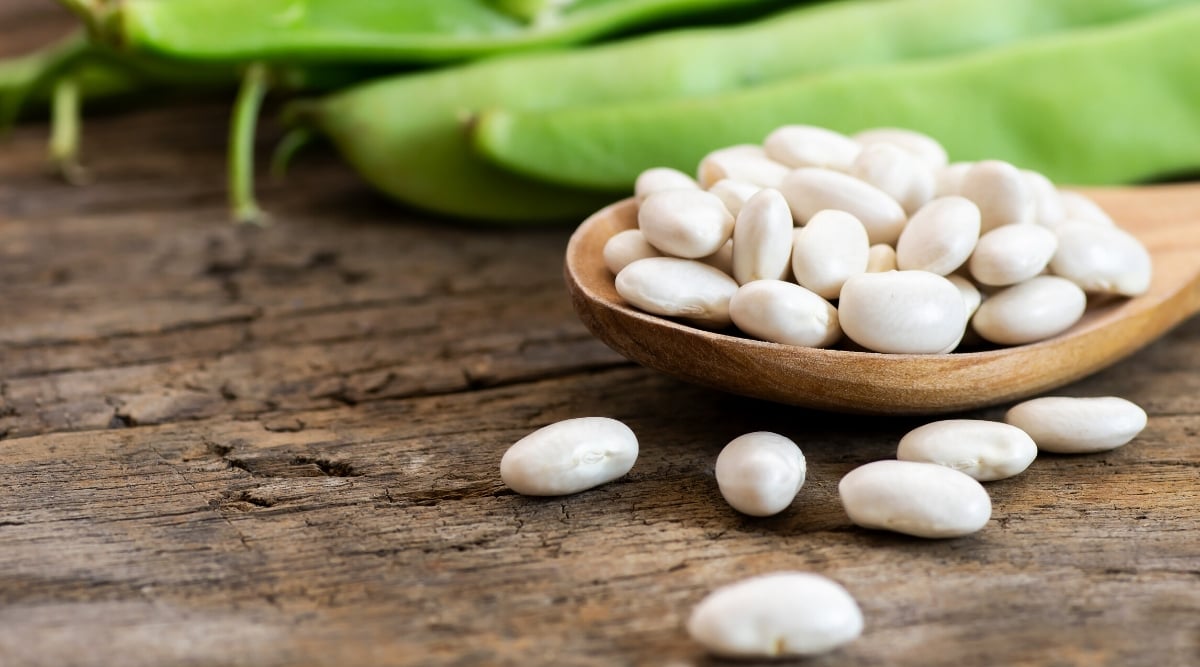
This heirloom variety was first introduced in 1888 and is native to Pennsylvania. It produces 5 inch green pods with white beans inside. It’s a vigorous climber, reaching 8 to 9 feet tall, which means you’ll need a good support to keep them happy.
The plants of these beloved beans are adapted to both cool and warm summers, growing well in the north and south. The plants may be tall-growing, but large containers can house them easily as long as they have a trellis. The pods are 4 to 5 inches, and contain about 5 beans each.
Great Northern

This heirloom variety is perfect for drying. The plants produce flat 5 inch green pods that contain white beans. These semi-vining plants are more compact than other pole varieties that can take up quite a bit of space. Yours should top out at about 2 feet.
The Great Northern was originally cultivated by the Mandan people in the Dakotas. Most of the time, the beans are dried and cooked or baked. Green beans can be eaten off the vine. This is a bean that is well suited to the seasons of the Northern US, as its name suggests.
Black Turtle

These compact bush plants produce dark purple-black beans and are widely grown and used culinarily throughout Latin America. This variety contains a high concentration of anthocyanin too, as evidenced by their black color!
These black beans can successfully be grown in warm and cool summers, and growing in containers is an option. This is probably due to the history of the bean. Many strains were originally cultivated in Mexico, and then brought to the Northern US and hardened off to the cool summers there.
Final Thoughts
Now that you know all the different types of beans you can plant this season, the next step is picking the ones you think will grow best in your region! Each of these beans is well suited for growing in the home garden, so find the one that suits your hardiness zone best and give them a try this season!














